towing AUDI A7 2014 Owners Manual
[x] Cancel search | Manufacturer: AUDI, Model Year: 2014, Model line: A7, Model: AUDI A7 2014Pages: 306, PDF Size: 76.83 MB
Page 5 of 306
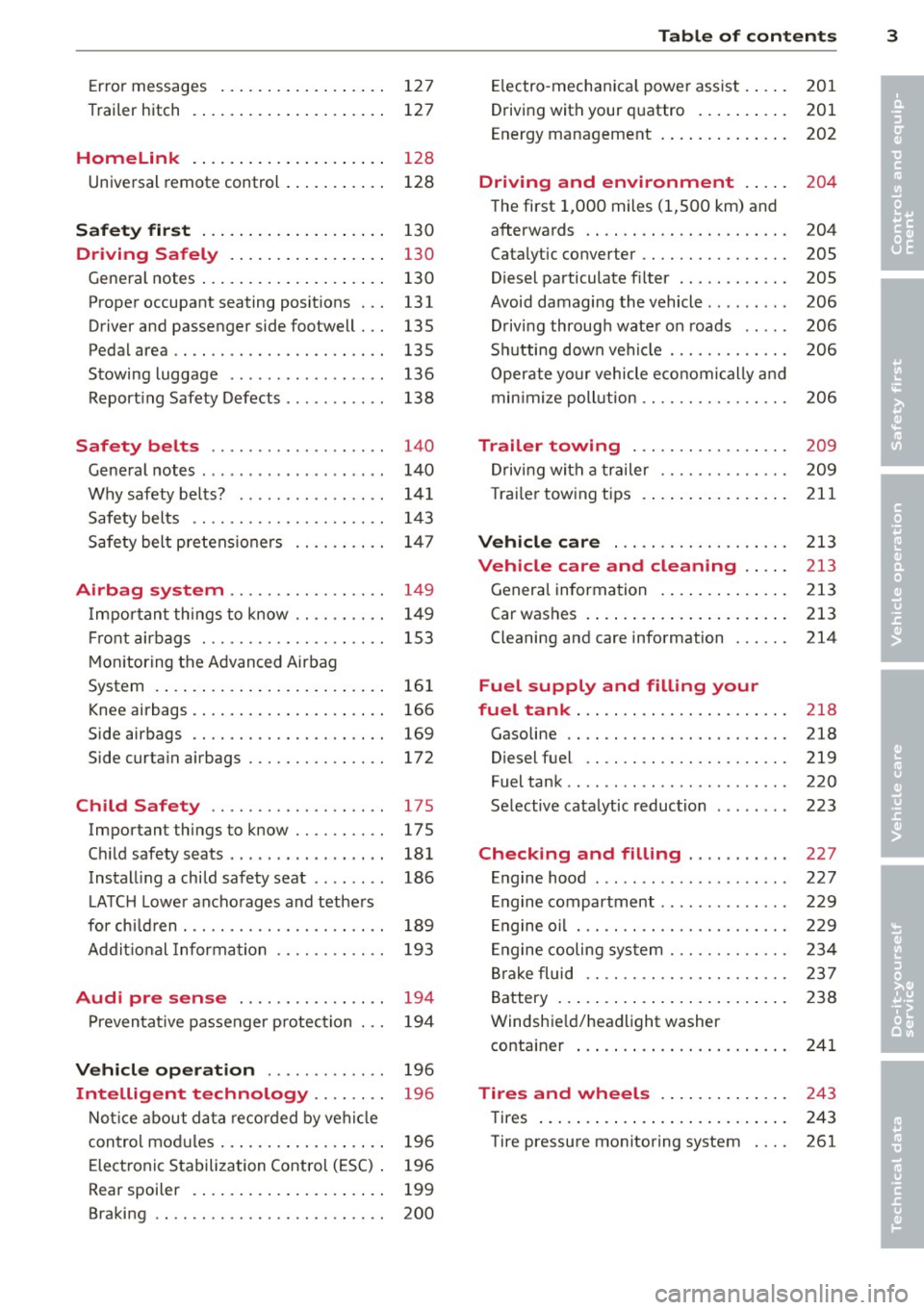
Error messages . . . . . . . . . . . . . . . . . . 127
Trailer hitch . . . . . . . . . . . . . . . . . . . . . 127
Homelink 128
Universal remote control . . . . . . . . . . . 128
Safety fir st . . . . . . . . . . . . . . . . . . . . 130
Dri ving Safely . . . . . . . . . . . . . . . . . 130
Gene ral notes . . . . . . . . . . . . . . . . . . . . 130
Proper occupant seating posit ions . . . 131
Driver and passenger side footwell . . . 135
Pedal area . . . . . . . . . . . . . . . . . . . . . . . 135
Stowing luggage . . . . . . . . . . . . . . . . . 136
Report ing Safety Defects . . . . . . . . . . . 138
Safety belts . . . . . . . . . . . . . . . . . . . 140
Ge neral notes . . . . . . . . . . . . . . . . . . . . 1 40
Why safety be lts? . . . . . . . . . . . . . . . . 141
Safety belts . . . . . . . . . . . . . . . . . . . . . 1 43
Safety bel t pre tens io ners . . . . . . . . . . 147
Airbag system ........... .. .. . .
Impo rtan t th ings to know .. .. .. .. . .
Fr ont airbags . ........... .. .. .. . .
M on itoring the Advanced Airbag
System .... .. .. ... . .... ... .. .. . .
K nee airbags . .. .. ..... ... .. .. .. . .
Side airbags .. ........... .. .. .. . .
Side curta in a irbags ....... .... .. . .
Child Safety ............... .. . .
Important things to know .. .. .. .. . .
C hi ld safety seats ... ...... .... .. . .
Install ing a child safety seat .. .. .. . .
L ATC H Lower ancho rages and tethe rs
for ch ild ren . ............. .... .. . .
Addit ional Information
Audi pre sense ..... ... .. .. .. . .
P reven tat ive passenger p rotection 149
1
4 9
1 53
16 1
166
169
172
175
175
181
186
189
193
194
194
Vehicle operat ion . . . . . . . . . . . . . 196
Intelligent technology . . . . . . . . 196
N ot ice about da ta re cor ded by veh icle
control mod ules . . . . . . . . . . . . . . . . . . 196
Elec tronic Stabilization Control (ESC) . 196
Rear spoiler . . . . . . . . . . . . . . . . . . . . . 199
Braking . . . . . . . . . . . . . . . . . . . . . . . . . 200
Table of contents 3
El ectro -mechan ica l powe r ass ist . . . . . 201
Driving with your q uattro . . . . . . . . . . 201
Energy management . . . . . . . . . . . . . . 202
Driving and environment . . . . . 20 4
The first 1,000 miles (1,500 km) and
afterwards . . . . . . . . . . . . . . . . . . . . . . 204
Catalytic converter . . . . . . . . . . . . . . . . 205
Diesel pa rticulate f ilter . . . . . . . . . . . . 205
Avoid damaging the vehicle . . . . . . . . . 206
Driving through water on roads . . . . . 206
S hu tting down veh icle . . . . . . . . . . . . . 206
Operate yo ur vehicle economi cally and
min imi ze poll ution . . . . . . . . . . . . . . . . 206
Trailer towing . . . . . . . . . . . . . . . . . 209
D rivi ng with a trailer . . . . . . . . . . . . . . 209
T rai le r tow ing tips .. . .. .. ..... ... . 211
Vehicle care . . . . . . . . . . . . . . . . . . . 2 13
Vehicle care and cleaning . . . . . 213
Genera l information . . . . . . . . . . . . . . 213
Car was hes . . . . . . . . . . . . . . . . . . . . . . 213
Cleaning and care information . . . . . . 214
Fuel supply and filling your
fuel tank ... .. .... .. .. ...... ... .
218
Gasoline . . . . . . . . . . . . . . . . . . . . . . . . 218
Diesel fuel . . . . . . . . . . . . . . . . . . . . . . 219
Fuel tank . . . . . . . . . . . . . . . . . . . . . . . . 220
Se lective catalytic reduc tion . . . . . . . . 223
Checking and filling . . . . . . . . . . . 227
E n gine hood . . . . . . . . . . . . . . . . . . . . . 227
Engine compartment . . . . . . . . . . . . . . 229
En gine o il . . . . . . . . . . . . . . . . . . . . . . . 229
E ngine cooling system . . . . . . . . . . . . . 234
Br ake fluid . . . . . . . . . . . . . . . . . . . . . . 23 7
Battery . . . . . . . . . . . . . . . . . . . . . . . . . 238
Windshie ld/headlight washer
container . . . . . . . . . . . . . . . . . . . . . . . 241
Tires and wheels . . . . . . . . . . . . . . 243
Tires . . . . . . . . . . . . . . . . . . . . . . . . . . . 243
Tire pressure monitoring system . . . . 261
•
•
Page 6 of 306
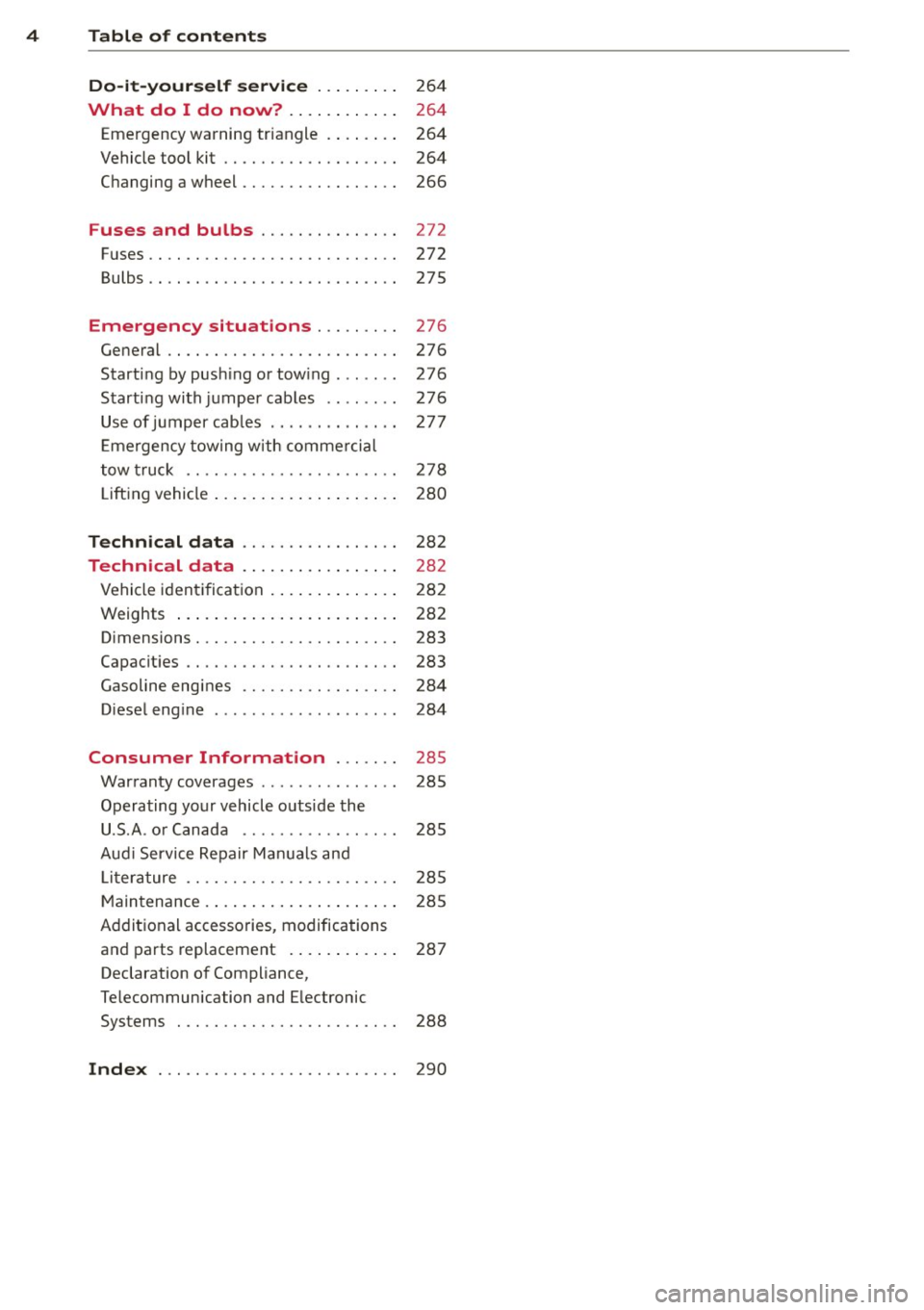
4 Table of contents
Do-it-yourself ser vice . . . . . . . . .
264
What do I do now? . . . . . . . . . . . . 264
Emergency warning triangle . . . . . . . . 264
Vehicle tool kit . . . . . . . . . . . . . . . . . . . 264
Changing a wheel . . . . . . . . . . . . . . . . . 266
Fuses and bulbs . . . . . . . . . . . . . . . 272
Fuses. . . . . . . . . . . . . . . . . . . . . . . . . . . 272
Bulbs........................... 275
Emergency situations ......... 276
General . . . . . . . . . . . . . . . . . . . . . . . . . 276
Starting by pus hing or tow ing . . . . . . . 276
Start ing with jumper cab les . . . . . . . . 276
Use of jumper cab les . . . . . . . . . . . . . . 2 77
E mergency towing with comme rcial
tow truck . . . . . . . . . . . . . . . . . . . . . . . 278
L ift ing vehicle . . . . . . . . . . . . . . . . . . . . 280
Technical data . . . . . . . . . . . . . . . . . 28 2
Technical data . . . . . . . . . . . . . . . . . 282
Vehicle ident ificat ion . . . . . . . . . . . . . . 282
Weights . . . . . . . . . . . . . . . . . . . . . . . . 282
Dimensions. . . . . . . . . . . . . . . . . . . . . . 283
Capacit ies . . . . . . . . . . . . . . . . . . . . . . . 283
Gasoline engines . . . . . . . . . . . . . . . . . 284
Diese l eng ine . . . . . . . . . . . . . . . . . . . . 284
Consumer Information . . . . . . . 285
Warranty coverages . . . . . . . . . . . . . . . 285
Operating your vehicle outside the
U.S .A. o r Canada . . . . . . . . . . . . . . . . . 285
Audi Service Repair Ma nuals and
L it erature . . . . . . . . . . . . . . . . . . . . . . . 285
M ain tenance . . . . . . . . . . . . . . . . . . . . . 285
Additional accessories, modifications
and parts replacement . . . . . . . . . . . . 287
Declaration o f Compliance,
Te lecommunication and Electronic
Systems . . . . . . . . . . . . . . . . . . . . . . . . 288
Index . . . . . . . . . . . . . . . . . . . . . . . . . . 290
Page 26 of 306
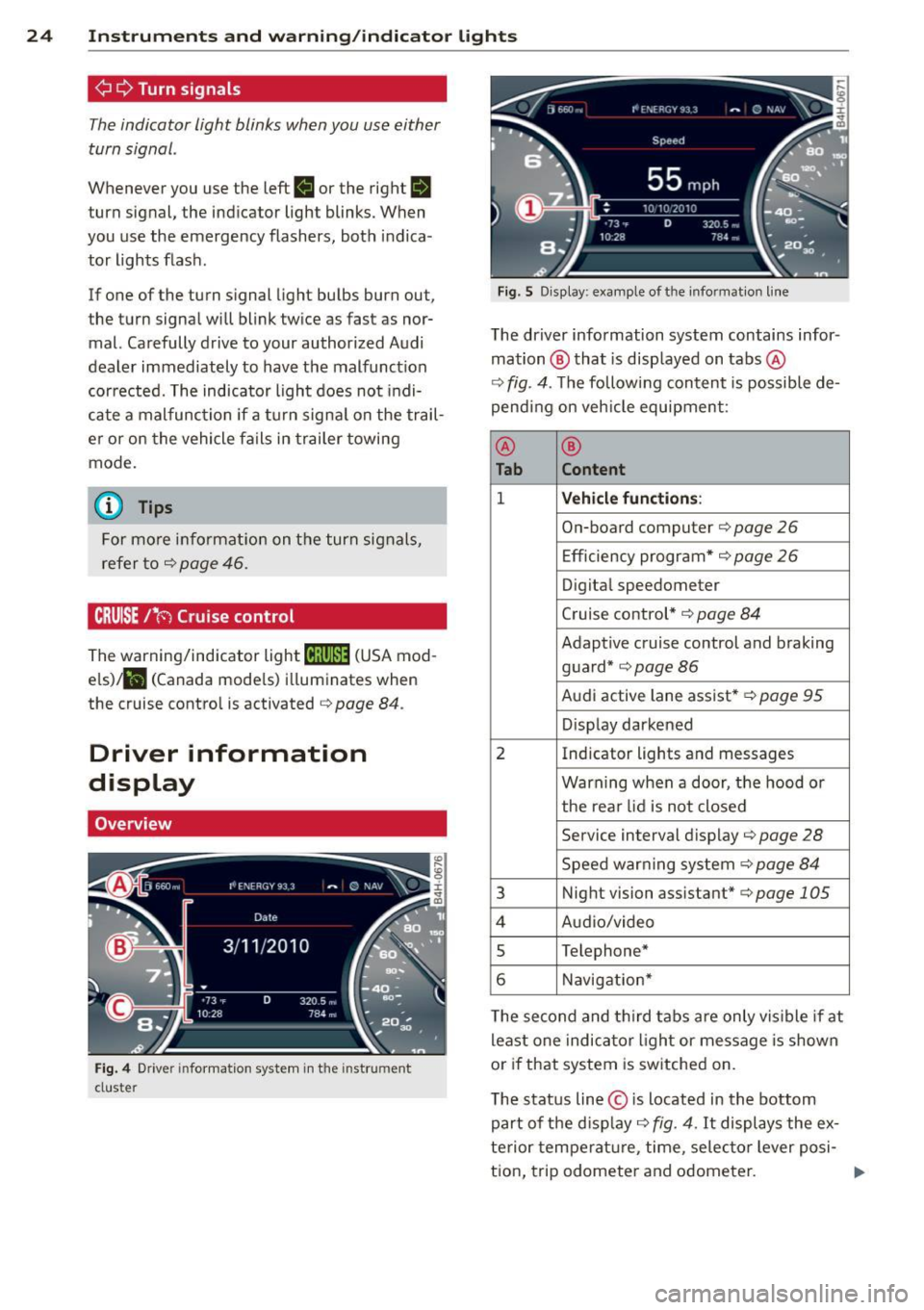
24 Instr uments and warning/indicator lights
¢¢Turn signals
The indicator light blinks when you use either
turn signal .
Whenever you use the left II or the rig ht a
turn signal, the indicator light blinks. When
you use the emergency flashers, both indica
tor lights flash.
If one of the turn signal light bulbs burn out,
the turn signal will blink twice as fast as nor
mal. Carefully drive to your authorized Audi
dealer immediately to have the malfunction
corrected. The indicator light does not indi
cate a malfunction if a turn signal on the trail
er or on the vehicle fails in trailer towing
mode.
@ Tips
For more informat ion on the turn signals,
refer to
c::> page 46.
CRUISE/" (') Cruise control
The warning/indicator light (ij;(l)~i~ (USA mod
e ls)/ il (Canada mode ls) illuminates when
the cruise contro l is activated
c::> page 84.
Driver information
display
Overview
Fig. 4 Driver information system in the instrument
cluster
Fig. 5 Disp lay: example of the informat ion line
The driver information system contains infor
mation ® that is disp layed on tabs@
c::> fig. 4. The following content is possible de
pending on veh icle equipment:
@ ®
Tab Content
1 Vehicle functions :
On-board computer c::> page 26
Efficiency program* c::> page 26
Digital speedometer
Cruise control*
c::> page 84
Adaptive c ruise control and braking
guard*
c::> page 86
Audi active lane assist* c::> page 95
Display darkened
2 Indicator lights and messages
Warning when a door, the hood or
the rea r lid is not closed
Service interval display
c::> page 28
Speed warning system c::> page 84
3 Night vision assistant* c::> page 105
4 Audio/video
s Telephone*
6 Navigation*
The second and third tabs a re only vis ible if at
least one indicator lig ht or message is shown
or if that system is switched on.
T he status line © is located in the bottom
part of the display
c::> fig. 4. It displays the ex
terior temperature , time, se lector lever posi-
tion, trip odometer and odometer. ..,.
Page 47 of 306
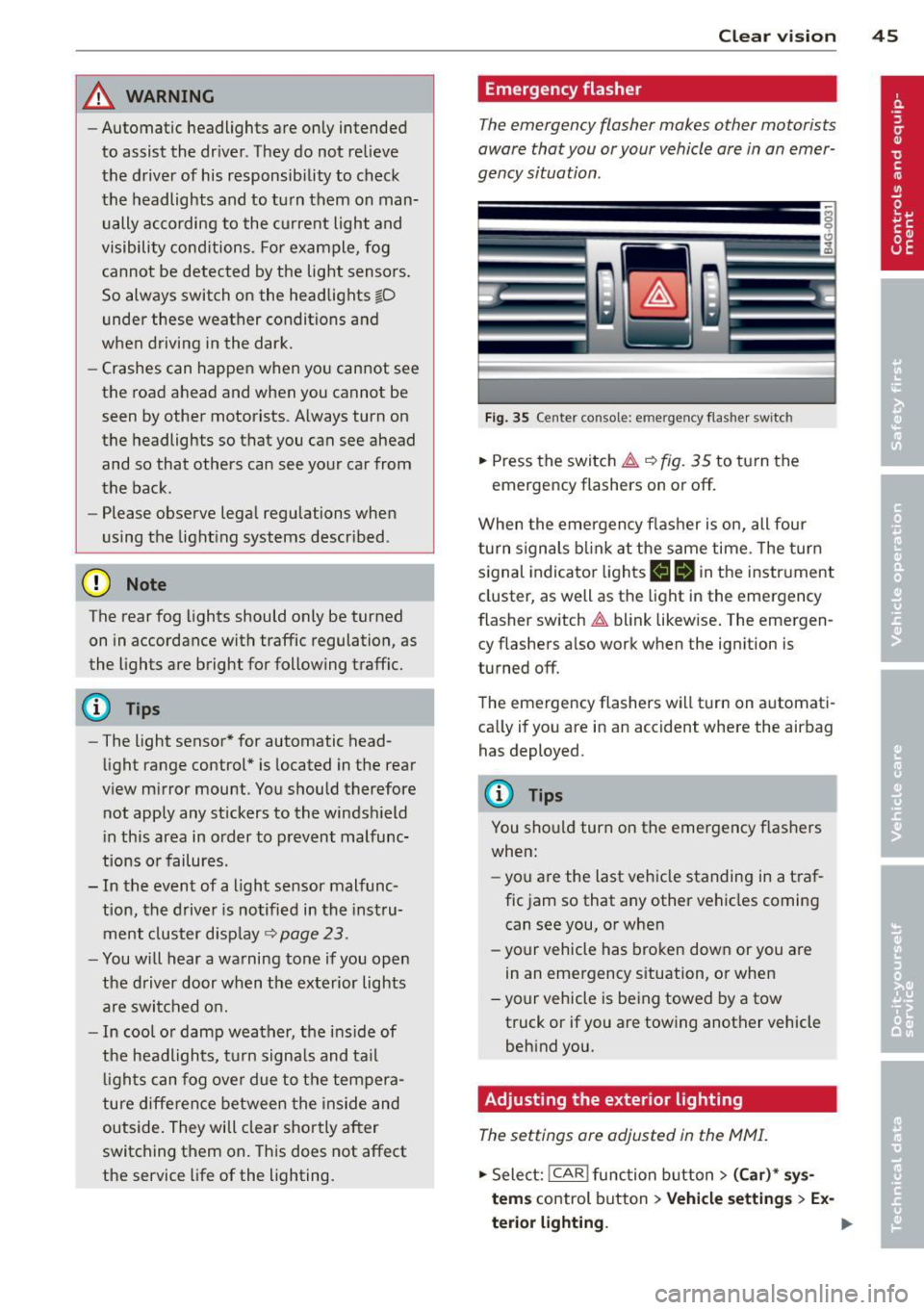
_& WARNING
-Automatic headlights are only intended
to assist the driver . They do not relieve
the driver of his responsibility to check
the headlights and to turn them on man
ually according to the current light and
visibility conditions. For example, fog
cannot be detected by the light sensors.
So always switch on the headlights
io
under these weather conditions and
when driving in the dark.
- Crashes can happen when you cannot see
the road ahead and when you cannot be
seen by other motorists. Always turn on
the headlights so that you can see ahead
and so that others can see your car from
the back.
- Please observe legal regulations when
using the lighting systems described.
(D Note
The rear fog lights should only be turned
on in accordance with traffic regulation, as
the lights are bright for following traffic.
(D Tips
- The light sensor* for automatic head
light range control* is located in the rear
view mirror mount. You should therefore not apply any stickers to the windshield
in this area in order to prevent malfunc
tions or failures.
- In the event of a light sensor malfunc
tion, the driver is notified in the instru
ment cluster display ~
page 23 .
-You will hear a warning tone if you open
the driver door when the exterior lights
are switched on.
- In cool or damp weather, the inside of
the headlights, turn signals and tail
lights can fog over due to the tempera
ture difference between the inside and
outside. They will clear shortly after
switching them on. This does not affect
the service life of the lighting.
Clear vision 45
Emergency flasher
The emergency flasher makes other motorists
aware that you or your vehicle are in an emer
gency situation .
Fig. 35 Center consol e: eme rge ncy flash er sw itc h
.,. Press the switch & ~ fig. 35 to turn the
emergency flashers on or off.
When the emergency flasher is on, all four
turn signals blink at the same time. The turn
signal indicator lights
II Nin the instrument
cluster, as well as the light in the emergency
flasher switch
& blink likewise. The emergen
cy flashers also work when the ignition is
turned off.
The emergency flashers will turn on automati
cally if you are in an accident where the airbag has deployed.
@ Tips
You should turn on the emergency flashers
when:
- you a re the last vehicle standing in a traf
fic jam so that any other vehicles coming
can see you, or when
- your vehicle has broken down or you are
in an emergency situation, or when
- your vehicle is being towed by a tow
truck or if you are towing another vehicle
behind you.
Adjusting the exterior lighting
The settings ore adjusted in the MMI.
.,. Select: !CAR ! function button> (Car)* sys
tems control button > Vehicle settings > Ex-
terior lighting. ..,.
Page 68 of 306
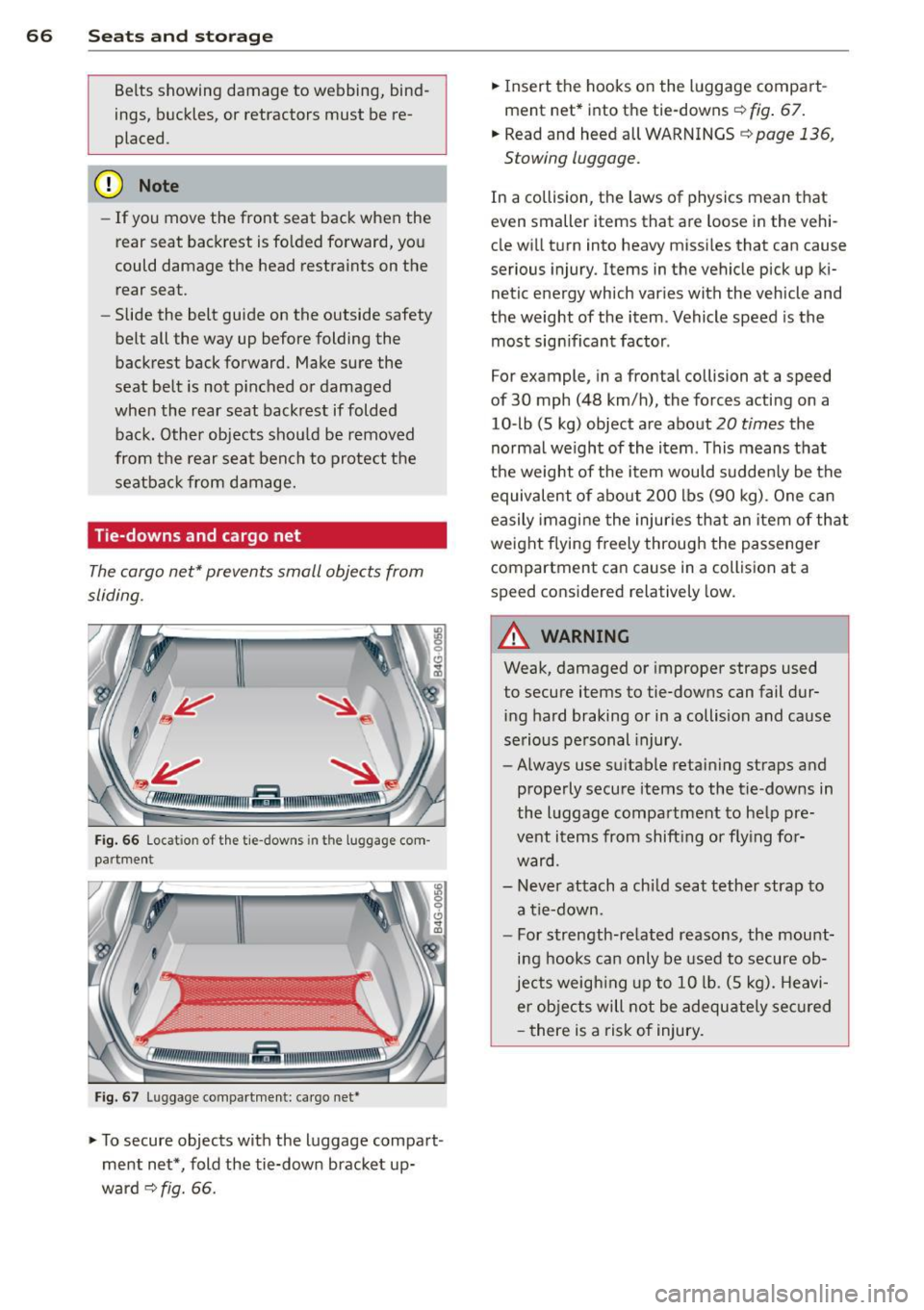
66 Seats and st o rage
Belts showing damage to webbing, bind
ings, buckles, or retractors must be re
placed.
(D Note
- If you move the front seat back when the
rear seat backrest is fo lded forward, you
could damage the head restraints on the
rear seat.
- Slide the belt guide on the outside safety
belt all the way up before folding the
backrest back forward. Make sure the
seat belt is not p inched or damaged
when the rear seat backrest if folded
back. Other objects shou ld be removed
from the rear seat bench to protect the
seatbac k from d amage.
Tie -downs and cargo net
The cargo net" prevents small objects from
sliding.
Fig . 66 Locat ion of the tie-downs in the luggage com
partment
Fig. 67 Luggage compartme nt: cargo net*
... To secure objects with the luggage compa rt
ment net*, fold the tie-down bracket up
ward
c:::> fig. 66. ...
Insert the hooks on the luggage compart
ment net* into the tie-downs
c:::> fig . 67.
... Read and heed all WARNINGS
c:::> page 136,
Stowing luggage.
In a collision, the laws of physics mean that
even smaller items that are loose in the vehi
cle wi ll turn into heavy missi les that can cause
serious injury. Items in the vehicle pick up ki
netic energy which varies with the veh icle and
the weight of the item . Vehicle speed is the
most sign ificant factor .
For example, in a frontal collision at a speed
of 30 mph (48 km/h), the forces acti ng on a
10-lb (5 kg) object are about
20 times the
normal we ight of the item . This means that
the weight of the item would sudden ly be the
equivalent of abo ut 200 lbs (90 kg). One can
easily imagine the injuries that an item of that
weight flying freely through the passenge r
compartment ca n cause in a collision at a
speed considered relatively low.
A WARNING
-
Weak, damaged or improper straps used
to secure items to tie-downs can fail dur
ing hard braking or in a collision and cause
serious personal injury.
- Always use suitable retaining straps and
properly secure items to the tie-downs in
the l uggage compartment to help pre
vent items from shift ing or fly ing for
ward.
- Never attach a chi ld seat tether strap to
a tie-down.
- For strength-related reasons, the mou nt
ing hooks can only be used to secure ob
jects weigh ing up to 10 lb. (5 kg). Heavi
er objects will not be adequ ately sec ured
- there is a risk of injury.
Page 101 of 306

General information
Applies to vehicles: with side ass ist
®
©
Fig . 104 Dr iving situations
Fig. 105 Rear of t he ve hicle: positio n of t he se nsors
"' a, 0 0
" a,
Side assist functions at speeds above approx i
mately 19 mph (30 km/h).
@ Vehicl es th at ar e approaching
In certain cases, a vehicle will be classified as
cr itical for a lane change even if it is still
somewhat far away. The faster a vehicle ap
p roaches, the sooner the display in the exteri
or m irror will t urn on.
@ Vehicles traveling with you
Vehicles traveling w ith you are indicated in the
exterior m irror if they are classified as cr itical
for a lane change. All vehicles detec ted by
side assist are indicated by the time they en
ter your "blind spot", at the latest.
Audi side assist 99
@ Veh icle s left behind
If you s low ly pass a vehi cle that s ide assist has
detected (the difference in speed between the
vehicle and you r vehicle is less than 9 mph or
15 km/h), the display in the exterior mirror
turns on as soon as the vehicle enters your blind spot.
The disp lay will not t urn on if you quickly pass
a vehicle that side assist has detected (the dif
ference in speed between the vehicle and your
vehicle is greater than 9 mph or 15 km/h).
Functi onal limitation s
The radar sensors are designed to detect the
left and right adjacent lanes when the road
lanes are the normal width. In certain situa
tions, the d isp lay in the exterior mirror may
turn on even though there is no veh icle locat
ed in the area that is cr itical for a lane change.
For example:
- if the lanes are narrow or if your are dr iving
on the edge of your lane.
If this is the case,
the system may have detected the vehicle in
another lane that is
not adjacent to your
current lane .
- if you a re driving through a curve. Side assist
may react to a vehicle that is one lane ove r
from the adjacent lane.
- if side assist reacts to other objects (such as
high or d isp laced guard rails) .
- In poor weather conditions. The side assist
functions are l imited .
Do not cover the radar sensors
c> fig. 105 with
stickers, depos its, bicycle wheels or other ob
jects, because this will affect the funct ion. Do
not use s ide ass ist when towing a trailer. For
i nformation on cleaning, refer to
c> page 213 .
_&. WARNING
-Always pay attention to traffic and to t he
area around your ve hicl e. S ide assist can
not replace a driver's attention. The driv
er a lone is always responsible for lane
changes and similar driving mane uvers.
Page 103 of 306

@ Tips
-Side assist is not active while you are
making the adjustment.
- Your settings are automatically stored
and assigned to the remote control key
being used.
Driver messages
App lies to vehicles: with side assist
If side assist switches off by itself, the LED in
the button turns off and a message will ap
pear in the instrument cluster display:
Audi side assist: Currently unavailable. No
sensor vision
The radar sensors' vision is affected. Do not
cover the area in front of the sensors with bike
wheels, stickers, dirt or other objects. Clean
the area in front of the sensors, if necessary
c> page 99, fig . 105.
Audi side assist: Currently unavailable
Side assist cannot be switched on temporarily
because there is a malfunction (for example,
the battery charge level may be too low).
Audi side assist: System fault!
The system cannot guarantee that it will de
tect vehicles correctly and it is switched off .
The sensors have been displaced or are faulty.
Have the system checked by an authorized
Audi dealer or authorized Audi Service Facility
soon.
Audi side assist: Unavailable when towing.
Side assist switches off automatically when a
factory-installed trailer hitch is connected to
the electrical connector on the trailer. There is
no guarantee the system will switch off when
using a retrofitted trailer hitch. Do not use
side assist when towing a trailer.
Audi side assist 101
Page 129 of 306

Error messages
Applies to vehicles: with parking system plus/rear view
camera/per ipheral cameras
There is an e rror in the system if the LED in
the
p, qA button is blinking and you hear a con
tinuous alarm for a few seconds afte r switch
ing on the parking system or when the park
ing system is already activated. If the error is
not corrected before you switch off the igni
tion, the LED in the
Pw.6. button will blink the
next time you switch on the parking system by
shifting into reverse.
Parking system plus
If a sensor is faulty, the~ symbol will appear
in front of/behind the vehicle in the Infotain
ment display. If a rear sensor is fau lty, only
obstacles that are in areas @ and @ are
shown ¢
page 117, fig. 122. If a front sensor
i s faulty, only obstacles that are in areas ©
and @are shown .
Peripheral cameras*
There is also a system error if:
- the
'(:8:)• • symbol appears in the display and
the corresponding display area is shown in
blue. The camera is not working in this area.
- all segments around the vehicles are red or
if no segments are displayed.
Drive to your authorized Aud i dea ler o r au
thorized repair fac ility immediately to have
the ma lfunction corrected.
Trailer hitch
Appl ies to vehicles: with parking system plus/rear view
camera/per ipheral cameras and trailer hitch
For vehicles using the tra iler socket, the park
ing system rear senso rs do not turn on when
you shift into reverse gear or when yo u press
the P
01A button. This results in the following re
strictions:
Parking system plus*
There is no distance wa rning for the rear. The
front sensors rema in activated. The visual d is
play switches to the traile r tow ing mode.
Parking systems 127
Parking system plus and rear view
camera* /Peripheral cameras*
There is no distance warning for the rear. The
front sensors remain activated. The visual dis
play switches to the trailer towing mode. The
rear view camera image will not show the ori
entation lines and the blue surfaces .
{D Tips
Trailer hitches that are not installed at the
factory may cause the park ing system to
malfunction or they may restr ict its func
tion.
Page 138 of 306
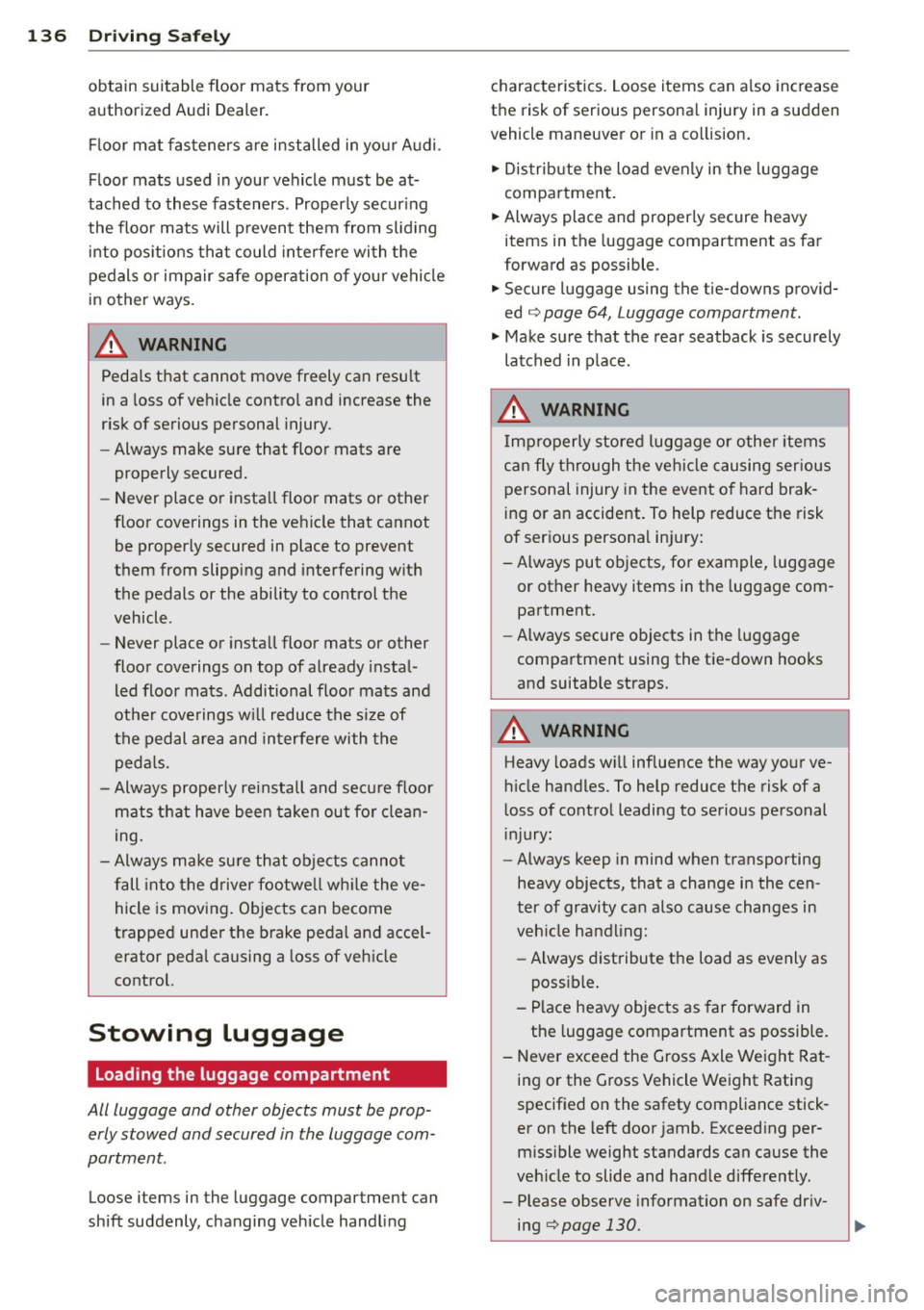
136 Driving Saf ely
obtain sui table flo or mats from your
authorized Audi Dealer.
F loor mat fasteners are installed in your Audi .
Floor mats used in your vehicle must be at
tached to these fasteners . Properly secur ing
the floor mats will prevent them from sliding
i nto pos itions that could interfe re wi th the
pedals or impair safe operation o f your vehicle
in other ways .
A WARNING
Pedals that cannot move freely can resu lt
in a loss of veh icle contro l and increase the
r isk of serious personal injury .
- Always make sure that floor mats are
properly secured.
- Never place or insta ll floor mats or other
floor coverings in the vehicle that cannot
be properly secured in place to prevent
them from slipping and interfering w ith
the pedals or the ability to control the
vehicle .
- Never place or install floor mats or other
floor coverings on top of a lready insta l
led floor mats . Additional floor mats and
other cove rings w ill reduce the si ze of
the pedal area and interfere with the peda ls.
- Always properly reinstall and se cu re floor
mats that have been taken out for clean
ing.
- Always make su re that obje cts canno t
f all into the driver footwe ll wh ile the ve
hicle is moving . Objects can become
t rapped under the b rake pedal and accel
erator peda l causing a loss of veh icle
control.
Stowing luggage
Loading the luggage compartment
All luggage and other objects must be prop erly stowed and secured in the luggage com
partment.
Loose i tems in the luggage compartmen t can
shift suddenly, changing veh icle hand ling characteristics. Loose items can a
lso increase
the risk of s erious persona l injury in a sudden
vehicle maneuver o r in a co llision .
.. Dis trib ute the load even ly in the luggage
compa rtment .
.. Always place and properly secure heavy
items in the luggage compartment as far
forward as possible .
.. Secure luggage using the tie-downs prov id
ed
¢ page 64, Luggage compartment .
.. Make sure that the rear seatback is securely
latched in place.
A WARNING
Imp roperly stored luggage or other items
can fly thro ugh the vehi cle causing ser ious
personal injury in the event of hard brak
i ng or an accident. To help reduce the risk
of ser ious personal in ju ry:
- Always put ob jects, fo r example, luggage
or other heavy items in the luggage com
partment.
- Always secure objects in the luggage
compa rtment us ing the tie-down hooks
and suitable straps.
A WARNING
-
Heavy loads w ill influence the way yo ur ve-
h icle handles. To help reduce the risk of a
l oss of cont ro l leading to serious personal
in Jury :
- Always keep in mind when transporting
heavy objects , that a change in the cen
ter of gravity can also cause changes in
veh icle handling:
- Always distribute the load as evenly as
poss ible .
- Place heavy objects as far forward in the luggage compartment as possible.
- Never exceed the Gross Axle We igh t Rat
ing or the Gross Vehicle Weight Rating
specif ied on the safety compliance stick
er on the left door jamb. Exceeding per
miss ible weight standards can cause the
veh icle to slide and hand le diffe rently.
- Please observe information on safe dr iv
ing¢
page 130.
Page 198 of 306
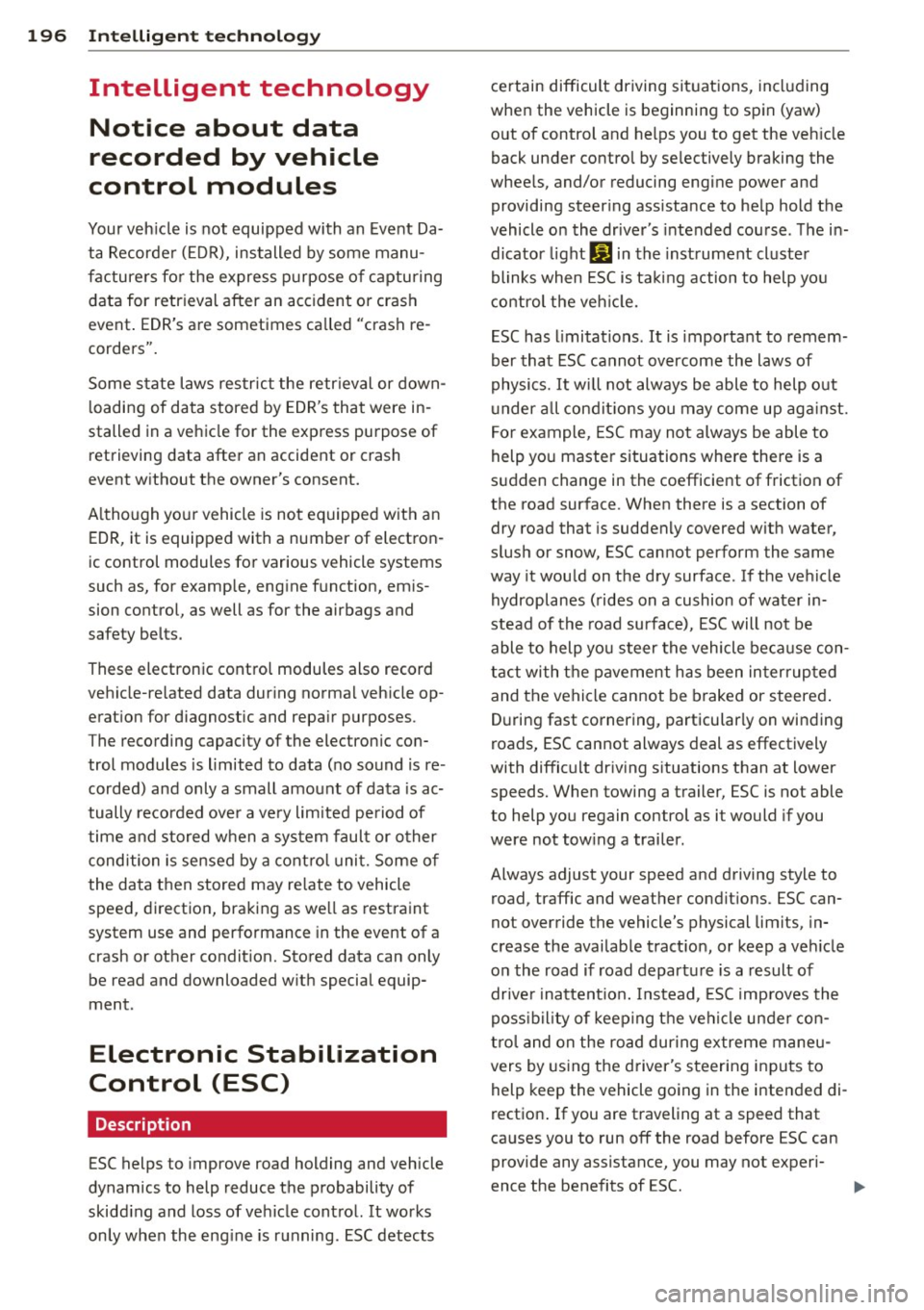
196 Intelligent technology
Intelligent technology
Notice about data
recorded by vehicle
control modules
Your vehicle is not equipped with an Event Da
ta Recorder (EDR), installed by some manu
facturers fo r the express purpose of capturing
data for retrieval after an accident or crash
event . EDR's are sometimes ca lled "crash re
corders".
Some state laws restrict the retr ieval or down
loading of data stored by EDR's that were in
stalled in a vehicle for the express purpose of
retrieving data after an accident or crash
event without the owner's consent.
A lthough your vehicle is not equipped with an
EDR, it is equipped with a number of electron
ic control modules for various vehicle systems
such as, for examp le, eng ine function, em is
sion control, as well as for the airbags and
safety belts.
These electronic contro l modules also record
vehicle-re lated data during normal vehicle op
eration for diagnostic and repair purposes.
The recording capacity of the electronic con
trol modules is limited to data (no sound is re
corded) and only a small amount of data is ac
tually recorded over a very limited pe riod of
time and stored when a system fault or other
condition is sensed by a control unit. Some of
the data then stored may relate to vehicle
speed, direction, braking as we ll as restraint
system use and performance in the event of a
crash or other condition. Stored data can only
be read and downloaded with special equip
ment.
Electronic Stabilization
Control (ESC)
Description
ESC helps to improve road holding and vehicle
dynamics to help reduce the probability of
skidd ing and loss of vehicle control. It works
only when the engine is running. ESC detects certain difficult driving situat
ions, including
when the vehicle is beginning to spin (yaw)
out of control and helps you to get the veh icle
back under control by se lectively braking the
wheels, and/or reducing engine power and
providing steering assistance to help hold the
vehicle on the driver's intended course. The in
dicator light
G) in the instrument cluster
blinks when ESC is taking action to help you
control the vehicle.
ESC has limitations.
It is important to remem
ber that ESC cannot overcome the laws of
physics. It wi ll not always be able to help out
under all conditions you may come up against.
For example, ESC may not always be able to
help you master situations where there is a
sudden change in the coefficient of friction of
the road surface. When there is a section of
dry road that is suddenly covered with water,
slush or snow, ESC cannot perform the same
way it wou ld on the dry surface . If the vehicle
hydroplanes (rides on a cushion of water in
stead of the road surface), ESC will not be
able to help you steer the vehicle because con
tact with the pavement has been interrupted
and the vehicle cannot be braked or steered.
During fast cornering, particularly on winding
roads, ESC cannot always deal as effectively
with difficult driving situations than at lower
speeds. When towing a trailer, ESC is not able
to help you regain control as it would if you
were not tow ing a trailer.
Always adjust your speed and driving style to road, traffic and weather condit ions. ESC can
not override the vehicle's physical limits, in
crease the available traction, or keep a vehicle
on the road if road departure is a result of
drive r inattention. Instead, ESC improves the
poss ibility of keeping the vehicle under con
trol and on the road during ex treme maneu
vers by using the driver's steering inputs to
help keep the vehicle going in the intended di
rection . If you are traveling at a speed that
causes you to run off the road before ESC can
provide any assistance, you may not experi
ence the benefits of ESC.